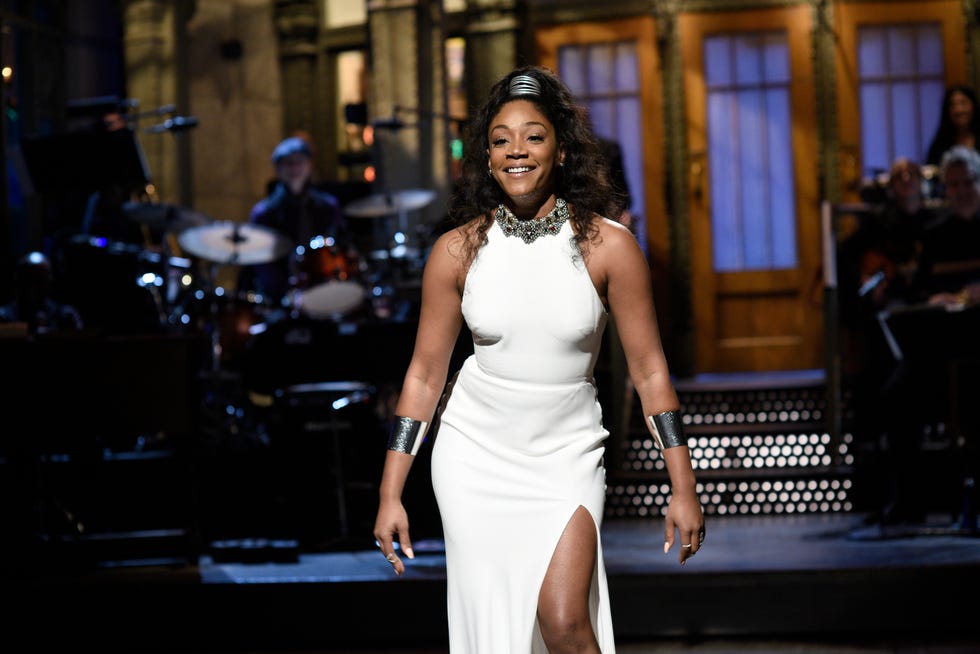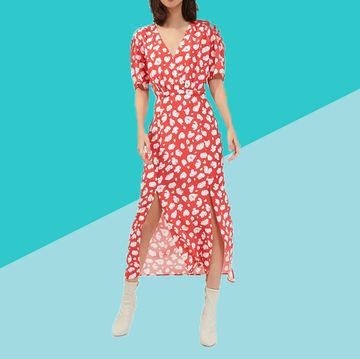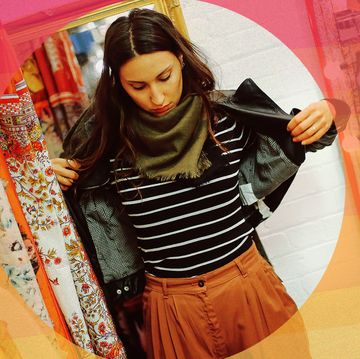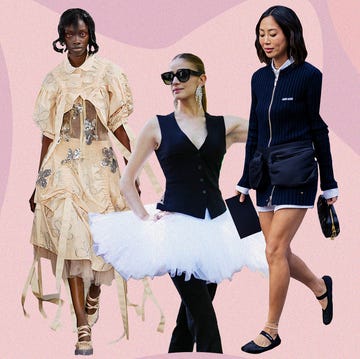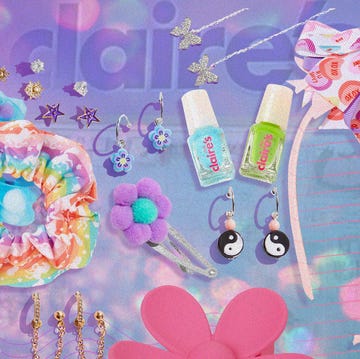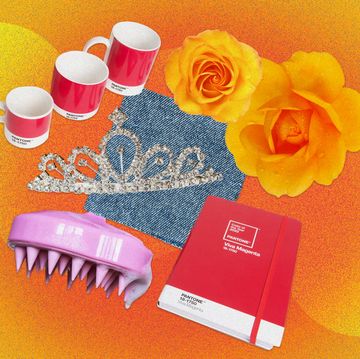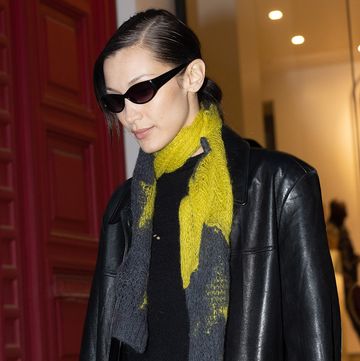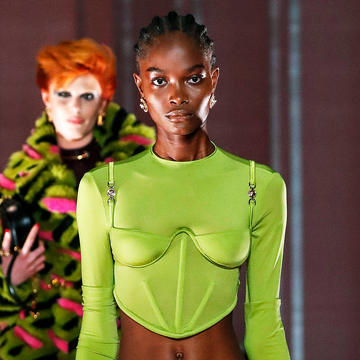When the lockdown hit, loungewear sales soared. While fashion brands largely relied on marketing gimmicks to stay afloat, companies capable of pivoting their direction — think Kim Kardashian’s Skims’ evolution from body-binding underwear to collections of soft stretch fabrics — did so. It made sense. Women around the world, no longer forced to work within the “who, what, and where” parameters of their daily schedule, chose comfort. As such, we embraced donning variations of the same thing every day.
Although, for many, the transition likely came as a shock. There’s a reason uniforms are so readily scorned; workplace or school costumes were designed, we figured, to strip us of all individuality. Others embraced the rotation of fewer garments with a sigh of relief. When everything else felt so uncertain — our income, living situation, social life — at least we didn’t have to think about what to wear.
Founder of the Fashion Psychology Institute and the world’s first fashion psychologist, Dr. Dawnn Karen believes clothing to be key when it comes to alleviating anxiety. When she herself was reckoning with past trauma, Dr. Karen turned to clothes, noting that expressing herself through fashion returned her sense of control. To clients, she recommends dressing according to mood — and explains that we’ve become so accustomed to dressing for external factors (read: weather, social expectations, trends), we’ve overlooked how we feel. Repetitious dressing in particular, she claims, can work wonders on your mental health.
“My take on the psychology behind the true uniform relates to a theory of mine called ‘repetitious wardrobe complex’ — essentially, it’s wearing the same outfits to minimize anxiety and decision fatigue.”
You might recognize the term “decision fatigue” as a buzz phrase most commonly associated with Facebook founder Mark Zuckerberg. Zuckerberg’s trademark look — a gray T-shirt, a gray hoodie, and a pair of dark wash jeans — had been the source of much speculation, and in 2014 he was asked to unpack his sartorial expression. The tech giant revealed that when facing so many daily decisions, it felt like a victory to eliminate one. Four years earlier, Obama shared a similar sentiment with Vanity Fair. “You’ll see I wear only gray or blue suits. I’m trying to pare down decisions,” he said.
They’re not alone. The late Steve Jobs was famous for his black turtleneck, Levi’s 501 jeans, and New Balance sneakers — worn from 1998 until his death in 2011. Karl Lagerfeld owned 1,000 versions of his white, high-collared shirt. Then there’s Fran Lebowitz, who reentered the cultural zeitgeist with a bang at the top of the year with her new docuseries, Pretend It’s a City, in the same blazer, shirt, and jeans combination she’s subscribed to for at least 50 years.
In truth, it can be empowering to adopt a signature style, says KJ Moody, the creative director and stylist for Beyoncé’s Parkwood Entertainment. He personally “loves” when someone carves out their niche — he believes that this increases the mystique of creatives.
“We are all familiar with Steve Jobs’ turtleneck and jeans and Richard Branson’s jeans, shirt, and jacket,” he says. “These are all highly creative people who have chosen to focus their talents on their passion. Let’s face it — routines work. That’s how trends are started.”
However, the celebrity routine looks a little different. Madison Guest, who has styled the likes of Serena Williams and Victoria Justice, claims that she is often asked to align a star’s personal aesthetic to what they’re promoting. Their unbridled access to top designers means Guest’s clients rarely express interest in a uniform; nonetheless, she appreciates fashionistas who maintain a capsule-esque approach to style.
“Rosie Huntington-Whitely does it best, in my opinion,” she says. “She has a very clear aesthetic and sticks to a color palette and silhouettes that she knows work for her. She also re-wears and mixes and matches a lot in her closet, all while looking like she’s in a chic editorial.”
For Moody, it’s Janelle Monáe who best toes the line between ongoing evolution and commitment to one aesthetic: androgyny. “Her beautiful tuxedo looks [were] always slightly different but kept the same beautiful and classy aesthetic. I think it shows confidence that you can commit to a concept and completely envelope it and make it your own.”
Of course, there’s more to self-presentation uniformity than wearing the same clothes day in, day out: Cosmetics commitment can bring similar comfort. During World War II, Elizabeth Arden created a red lipstick to match the uniforms of the U.S. Marine Corps Women’s Reserve, while other brands named their products “Fighting Red” or “Commando” for women to associate lipstick as a kind of necessary armor. Beauty had become a coping mechanism, and product loyalty became a personal signature.
In the decades since, many famous women have adopted this attitude — pledging allegiance to one product or signature look. Marilyn Monroe was famously loyal to Chanel No. 5, revealing she wore the fragrance and nothing else to bed. Taylor Swift’s Speak Now and Red eras famously featured her red-hued lips in every promotional image, and her later album covers for 1989, Reputation, and Lover also featured Swift in a bold lip. Throughout her 11-season tenure as a star on Modern Family, Sofia Vergara never appeared with natural-tinged lips.
These choices seem to be more socially acceptable for women who maintain a hyper-femme presence rather than repeating an outfit or garment. Actress Tiffany Haddish made a point of violating social expectations by re-wearing a white Alexander McQueen dress, which she appeared in on four separate occasions. In her SNL monologue, Haddish used the dress as a punch line — alleging she was getting her money’s worth of the $4,000 gown. Still, one has to ask why donning a dress for multiple occasions should bear the need for explanation at all and, moreover, why such a concept should serve as comic relief.
Dr. Karen believes the answer likely lies in the gender double standard of repetitive dressing. Women tend to be judged more frequently and harshly by their appearance, says Dr. Karen, which means “Men have more flexibility when it comes to wearing the same outfits, whereas women, they do not.” One wonders whether Haddish hoped to avoid the rigamarole that comes with sourcing and selecting a new outfit that would hold up against public scrutiny.
In large part, these social expectations have perpetuated a consumer culture that almost exclusively targets women. Even in early quarantine, haul videos garnered millions of views as style influencers unboxed sometimes dozens of packages from fast-fashion brands Fashion Nova, I.Am.Gia, and Nasty Gal. Others partner with Amazon to curate designer dupes and trendy pieces at a low cost for their followers. Thousands of fashionistas take to TikTok or Instagram reels to show off a range of outfits, many of which will never be seen on their online accounts again. As of 2019, the textile industry was responsible for 10 percent of global Co2 emissions and 20 percent of the world’s wasted water.
While adopting a style uniform might be an obvious solution, Moody suggests some might find repetition psychologically detrimental. Over time, he shares, there’s potential to become disassociated from dressing altogether. In short, whatever confidence you may have gained from knowing and buying for your body type might erode due to lack of variety.
“I think [a uniform] can be both positive and negative,” Moody says. “While it’s less stressful to not have to come up with outfits on a daily basis, it also has the potential to stop personal fashion exploration. While changing it up sometimes might give you anxiety, once you get that first compliment, it has the potential to open you up to an entirely new aesthetic.”
Nonetheless, there’s still room for experimentation without further contributing to the consumption crisis. “Shopping awareness,” Moody says, is the practice of pivoting one’s focus from trends and instead investing in pieces that defy season. Still, if the pull of a particular trend simply becomes too powerful, Guest suggests seeking something similar on vintage sites (seeing as trends are mostly cyclical, which means they can likely be sourced via consignment). After years of sifting through collections for clients, Guest’s personal style now prioritizes “quality over quantity.”
“I really try to not overbuy trendy things,” she shares. “If it’s something that feels like a whim, I put it on hold to make sure I really want it, even if the price is low — it keeps me from buying something I’ll really only wear once. I also try to buy and sell a lot through consignment. I think people get caught up in the idea of needing a new wardrobe each season, which simply isn’t true.”
For those looking to devise a signature style, Guest suggests taking into consideration your lifestyle and body type. While she “loves” her job as a stylist, even Guest can frequently become overwhelmed by access and options. As a result, she now buys less, investing in high-quality garments and wearing them “until they have holes.”
Dr. Karen actually recommends repetitive dressing — specifically, recycling outfits that you notice correspond with specific moods — to create an outfit that benefits you both mentally and physically. Self-reflection, she explains, is key to styling “from the inside out.”
“If you’re feeling kind of down, wear something that will illustrate that probe,” she offers. “The entire premise here is that you’re working with your core; you’re being true to yourself so that you can pass through the feelings as opposed to stuffing them and suppressing them.”
With the return of socializing upon us, we can now scroll through clip after clip of inspirations to dress for our summer of fun. Though the promise of a Covid-free paradise is certainly exciting, many of us have become accustomed to life at a slower pace. Gone will be the “all dressed up, nowhere to go” captions, because there soon will be somewhere, and somewhere else after that. The thought of deriving daily looks for work, parties, and dinners is even overwhelming for the fashion fluent, says Guest. And even if “uniform” isn’t in your style vocabulary, there is one definitive way to cope: Cull. Less choices, less stress.
“It certainly can feel like a lot trying to get ready each day,” Guest reveals. “The past few years, I’ve really edited down my closet, eliminating anything that causes too much extra thought.”
Beatrice Hazlehurst is a New Zealand–born writer covering culture, entertainment, and lifestyle for multiple outlets. She nomadically traverses both coasts, but currently you can find her by the beach in Southern California.
Get Shondaland directly in your inbox: SUBSCRIBE TODAY


